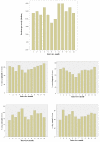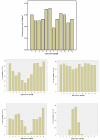Dietary Habits of Female Urban Slum-dwellers in Mumbai
- PMID: 23400755
- PMCID: PMC3568157
Dietary Habits of Female Urban Slum-dwellers in Mumbai
Abstract
RESEARCH QUESTION: Intakes of micronutrient-rich foods are low among women of child-bearing age living in slums. We investigated relationships between consumption of these foods and socio-demographic variables. METHODOLOGY: A 91-item Food Frequency Questionnaire was administered to women (n=1651) aged 16-40 yrs living in a Mumbai slum. We identified associations between categorical demographic variables and consumption frequency of these foods using chi-square tests. Associations with age and body mass index were investigated using one-way ANOVAs. RESULTS: A quarter of women ate fruit and green leafy vegetables < 3 times per week, Apart from in tea, median consumption of milk and milk products was < twice a week, 16% never consumed non-vegetarian foods. Median consumption of non-vegetarian foods was 4.5 times per week. Women employed in unskilled jobs and those whose husbands had skilled occupations ate green leafy vegetables more frequently. Participants educated to tertiary level consumed fruit and milk most frequently (p<0.05).
Keywords: India; diet; fruit; green leafy vegetable; milk; slum.
Figures
References
-
- Indian Council of Medical Research, National Institute of Nutrition . Nutrient requirements and recommended daily allowances for Indians. Hyderabad: 1989.
-
- National Institute of Nutrition, Indian Council of Medical Research . National Nutrition Monitoring Bureau. Report of Urban Surveys - Slums (1993-1994), Technical Report 15. Hyderabad: 1994.
-
- Seshadri S. Prevalence of micronutrient deficiency particularly of iron, zinc and folic acid in pregnant women in South East Asia. British Journal of Nutrition. 2001;85(2):S87–S92. - PubMed
-
- Agarwal KN, Agarwal DK, Sharma A, Sharma K, Prasad K, Kalita MC, et al. Prevalence of anaemia in pregnant & lactating women in India. Indian J Med Res. 2006;124(2):173–84. - PubMed
-
- Pandit D, Prabha R, Shanbhag R, Mayekar R. Morbidity Pattern of Women Attending Screening Program in an Urban Slum in Mumbai. Indian J Community Med. 2005;30(4):134–5.
Grants and funding
LinkOut - more resources
Full Text Sources
Research Materials


